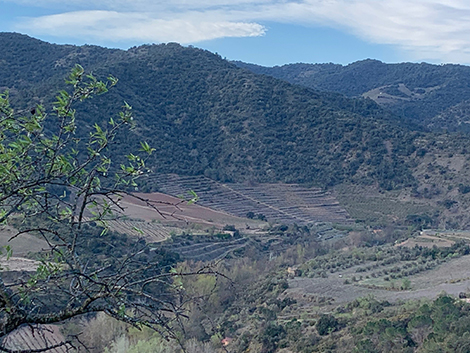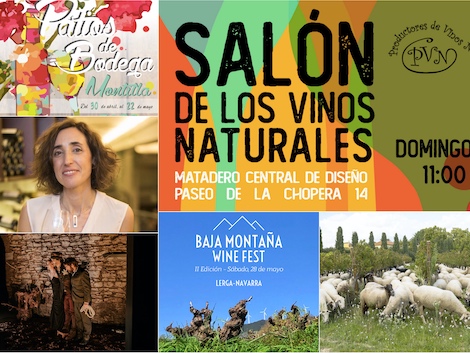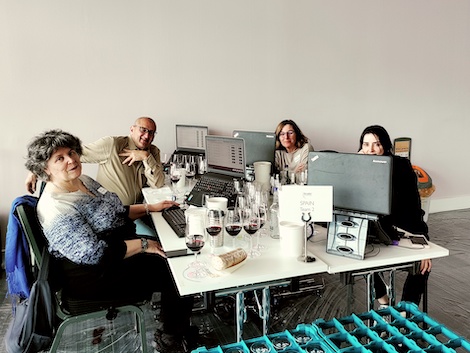
"In Priorat nothing can be done in a hurry. Time belongs to the land and vines set their own pace. This is something we have learnt," says Valentí Llagostera, as he contrasts the hustle and bustle of the city with the silence that reigns in this rugged, isolated region whose winding roads force people to slow down.
Wines also need their time to mature and reveal a terroir infused with strong features: slate soils (llicorella), variable aspects and the contrasting character of Garnacha and Cariñena, the region's two main grape varieties. Tasting them, both separately and blended over a 20-year span, was a unique experience that showed the different ways in which the territory emerges in the glass. The selection of vintages described below is the most comprehensive retrospective undertaken by Mas Doix to date.
Growing vines on costers
What has changed over the last 20 years? Most producers have realized that farming indigenous grapes (notably Garnacha and Cariñena) in Priorat’s traditional costers (right on the hillside) is the best approach. The trellised vineyards planted by Mas Doix in the 2000s are now being trained to a stake positioned at each vine (vertical axis) and Cabernet and Merlot have virtually disappeared, restricting international varieties to Syrah, which is well adapted to the area and provides ripe grapes with deep colour and spicy notes in 25-year-old vineyards.
"Ploughing with mules on costers makes a lot of sense," says Valentí Llagostera. "Soils are looser and rainwater flows in vertically preventing erosion." It also contributes to cut drops in yields in the case of old vines. "Plants don't usually die here, but the outer wood can dry out to such an extent that the sap cannot flow and new shoots die," he adds.

In such a harsh landscape, yields are barely 300g per plant in precious, hundred-year-old vineyards. In 2020, when mildew was rife, only 50,000 bottles were produced, compared to some 70,000 to 80,000 in a standard year. Conversely, in 2021, the snowfall at the beginning of the year, followed by cooling rains and mild temperatures in summer resulted in a generous harvest that might allow to fill 100,000 bottles.
An unlikely partnership
New alliances are shaping the future of Mas Doix. The company was founded in 1998 by brothers Ramón and Valentí Llagostera together with the Doix family, who farmed grapes well before phylloxera. In 2019, a new phase started: the Llagostera brothers acquired Doix's share and established a 50/50 partnership with an investor willing to fund the construction of new facilities.
The unlikely new partner was Cliff Lede, a Canadian-born construction businessman, and a lover of wine, art and music, who also owns an estate in Napa Valley (California). It was Remi Cohen, CEO at Lede Family Wines, who set the ball rolling during a prospecting trip to Europe that had Italy as its top investment destination. During a brief stop in Spain, Cohen arranged to visit Mas Doix, who happened to be the producer behind Salanques, one of her favourite red wines.
Perched on a hilltop surrounded by vineyards with stunning views of Poboleda, the new bodega was designed by Xavier Llagostera, Ramón and Valentí's architect brother. Sustainability was at the heart of the project. The winery operates with photovoltaic panels and a generator that provides additional support during harvest time. While the roof is conceived to collect as much rainwater as possible, the whole building was covered with the very slate extracted from the ground during the construction.

The winery, which is fully operative since the 2019 harvest, allows the Llagostera brothers to explore new winemaking possibilities with the introduction of a wooden vat and several concrete tanks. After the first fermentations and ageing experiences in concrete, this material seems particularly suitable for fining, preserving fruit and acidity and rounding tannins. Until then, all fermentations were carried out in stainless steel tanks.
Poboleda for freshness
Another key feature in Mas Doix wines is the location of the vineyards in one of the coolest villages in Priorat. Nestled between the Montsant and Molló mountain ranges, Poboleda benefits from dry, cold northeasterly winds avoiding the warm influence coming from the Ebro river. Whilst temperature is one and a half degrees lower than the Priorat average, rainfall is 10% higher. The village is known locally as "the Priorat frescal" (the fresh area of Priorat).
According to winemaker Sergi Batet, Cariñena pH is usually between 3.3 and 3.5, while Garnacha's may drop to 3.2.
The tasting showed how different these two varieties can be. The 1902 Centenary Carignan has longer records as it has been regularly produced since 2009, with the exception of 2011. It won't be released in the 2020 vintage as mildew was particularly devastating for Cariñena. The 1903 Centenary Grenache was first released in the 2015 vintage.
In 2011 none of the winery's top reds were produced and all their grapes went to Salanques. It was a dry, hot year with high night-time temperatures reaching 23ºC in August. At Mas Doix, it is regarded as their earliest, most overripe vintage.
Some useful data
Below is the thermal integral in Priorat for the 2006-2011 period whereas further down is a chart showing average rainfall and temperature figures from 1999 to 2021.

|
YEAR |
RAINFALL (mm) |
TEMPERATURE
(ºC) |
|
1999 |
- |
14,7 |
|
2000 |
707 |
15,1 |
|
2001 |
432 |
14,9 |
|
2002 |
605 |
15,1 |
|
2003 |
640 |
- |
|
2004 |
407 |
14,9 |
|
2005 |
460 |
- |
|
2006 |
334 |
15,9 |
|
2007 |
395 |
15,1 |
|
2008 |
680 |
14,9 |
|
2009 |
440 |
15,6 |
|
2010 |
518 |
14,5 |
|
2011 |
422 |
15,9 |
|
2012 |
410 |
15,5 |
|
2013 |
620 |
14,9 |
|
2014 |
545 |
15,9 |
|
2015 |
360 |
15,8 |
|
2016 |
450 |
15,5 |
|
2017 |
362 |
15,8 |
|
2018 |
700 |
15,6 |
|
2019 |
413 |
15,8 |
|
2020 |
633 |
15,8 |
|
2021 |
402 |
15,3 |
|
AVERAGE |
480 |
15,3 |
1903 Garnacha Centenaria
The current vintage of this wine is 2018. The 2019 will be names Coma de Cases and presented in burgundy-shaped bottles as shown in the photo below, and by 2020 they will be able to label it as Vinya Classificada.
Production is tiny: barely 300 to 400 bottles. Grapes are sourced from a west-facing coster of less than one hectare that doesn’t get any sunlight until 10 or 11am. This hillside facing the valley is permanently exposed to the wind so grapes grow in very healthy conditions.

This wine's distinctive character is partly due to a very specific Garnacha clone. Its small berries have fine, delicate skin, in contrast to the harder skin and more rustic tannins of other old vineyards in coster. Clusters are destemmed and sorted grape by grape. Alcoholic and malolactic fermentations take place in open barrels. The wine is not aged on its lees but undergoes post-fermentation maceration for about five days. Whilst new wood was used in vintages 2015 to 2017, seasoned barrels are the norm from 2018 onwards seeking to preserve herbal nuances, soften tannins and obtain a rounder mouthfeel.
Retail price in Spain ranges between €250 to €300.
2021 (barrel sample). This generous, balanced vintage with cooling rain and mild temperatures during the summer will help increase production to 500 bottles. A pure, fragrant wine with red fruit against a dark, slate background evolving towards fresh herbal notes. The weight on the palate and slightly warm notes on the finish is offset by the wine’s great acidity ending with a pure and very long finish. A beautiful and classy Garnacha.
2020 (bottle sample). Garnacha wasn’t as badly affected by mildew as Cariñena. Fruit is riper here with lots of herbs, a similar dark background and floral (violet) notes. Sweet fruit on the palate with lovely texture and tension. Crystalline purity and outstanding length. It gains lift as it develops in the glass.
2018. Cold, rainy vintage. Lots of black fruit notes at the beginning. Deep, fresh palate with some brandied fruit and acidity adding notable length. Tannins have weight on the first sip but as the wine gets some air, the texture comes closer to the purity of the previous two previous vintages.
2017. The absence of rainfall adds a bit of austerity to this vintage. A textbook priorat, this feels less lifted than previous vintages with herbal and slightly toasted aromas. The palate is broad and powerful with firm fruit and oak tannins, brandied fruit (blueberries) and an exuberant violet-scented finish. Definitely, a riper expression of Garnacha.
2015. This was the first vintage of 1903. On the nose, the herbal, exuberant notes stand above the oak and the soil’s mineral nuances. Lovely texture as expected from a wine that has spent some time in bottle with well-integrated acidity. Earthy, oak tannins are similar to 2017 but there is more finesse here.
1902 Centenary Carignan
This wine marked a turning point in the path of Mas Doix and of the region as a whole as it proved that Carignan grapes can produce some of the best reds in Priorat.
Grapes are sourced from several plots planted at the beginning of the 20th century in Tossal d'en Bou, a south-west facing site. The selection has become increasingly sophisticated over time. In 2012 a decision was made to use only the higher areas and use the remaining plots for Doix. 2019 will be the first vintage to be labelled as Gran Vinya Classificada, Priorat’s grand cru category.

The first vintages were made in a similar way to Doix, using new barrels and extracting more than at present. Pricewise, it costs about the same as the Grenache. Production does not exceed 1,000 bottles.
2021 (barrel sample). Ripening was slow and almost perfect on this vintage. Purple coloured, the nose is profound and floral, with blue fruit (blueberries) and lots of Mediterranean herbs. Citrus-like acidity, with much firmer tannins than the Garnacha. Impressive finish and aftertaste with a wealth of floral tones lingering for a long time.
2019 (bottle sample). This will be the first vintage labelled as Tossal d'en Bou under the new Gran Vinya Classificada category and in a Burgundy-shaped bottle. A heatwave at the end of June affected the Cariñena grapes. The wine is approachable and inviting now. It feels powerful but round, mellow and ripe, with abundant brandied fruit. Acidity greatly helps to gain balance. Very long finish but perhaps not as impressive as 2021.
2018. Set to be released this year, the nose is packed with herbal and mineral, dark aromas. Powerful and broad, the sweet fruit beautifully merges with the acidity resulting in a juicy palate with firm tannins leading to an aromatic, enveloping finish full of herbal notes. This wine is truly elegant and has great ageing potential.
2017. The current release started a bit closed, but gradually revealed a deep, dark nose (slate was very present) with remarkable complexity. Impressive, powerful, full-bodied and finely textured palate with plenty of aromatic herbs. An impressive red. 2017 shows clearly how different Garnacha and Cariñena can be in the same vintage. Whilst Garnacha struggled on this vintage, Cariñena is absolutely splendid.
2013. In this legendary vintage, probably the best of the 21st century in Priorat, 1902 lived up to expectations. Complex, fresh and with great depth, it showed remarkable finesse as a result of bottle ageing. Strikingly youthful, it boasts crisp acidity and tension, with a remarkably long finish. There are very few Cariñenas with such elegance and finesse.
2010. Another remarkable, almost textbook vintage, helped by the excellent weather conditions. After 12 years, the wine has mellowed and tempered its power. The nose was very dark and mineral, with toasted notes on the background. Finely textured palate armed with acidity that carries through a lively, long finish. Less energetic than previous vintages, with herbal notes on the aftertaste.
We also had the chance to taste two vintages that played a part in the creation of this wine but were never released. The 2006 was a little oaky compared to the previous wines, with liquorice notes and slightly rustic tannins, but it remained remarkably youthful. The 2005 displayed dark chocolate aromas and sweet fruit notes that were offset by the wine's ubiquitous acidity.
Doix Costers de Vinyes Velles
First made in 1999, this used to be the winery's top red until the release of 1902. Grapes are sourced from different vineyards in Poboleda, so it would easily fit in the vi de vila (village wine) category. The blend usually includes a bit more Cariñena than Garnacha (55% vs. 45%) and is slightly more extractive than the previous two. It retails at around €85-90 in Spain and production ranges between 3,500 and 5,500 bottles. This wine gave Mas Doix access to some international markets, particularly the US, after Robert Parker awarded it high scores.

2018. The current release combines a bit of what Garnacha and Cariñena represent: the dark aromas and notes of Priorat’s slate soils and the good depth of fruit and herbal notes. Powerful palate offset by the wine’s acidity that adds balance and length.
2017. Darker and riper than 2018 with toasted notes on the background. This wine has lots of everything: acidity, mid-palate and tannins. A vintage that will benefit from further bottle ageing.
2013. Remarkable aromatic intensity, with great depth and just a hint of oak. Broad, full palate with gorgeous, fresh minty flavours that bring an extra aromatic dimension and persist on the finish. This wine really fills the palate. Anyone with bottles of this vintage should be in no hurry to open them.
2002. Light colour. At this point there was 2% Merlot in the blend and I found some undergrowth notes that weren’t present in other vintages, but the vibrant palate and nerve was a telltale sign of Cariñena. Still very lively.
2001. Very different from 2002 and coming closer to Priorat’s dark, mineral side. The palate felt super fresh thanks to an acidity that seems eternal. The wine finishes with a rich, sweet, succulent note.

Amaya Cervera
A wine journalist with almost 30 years' experience, she is the founder of the award-winning Spanish Wine Lover website. In 2023, she won the National Gastronomy Award for Gastronomic Communication
NEWSLETTER
Join our community of Spanish wine lovers






